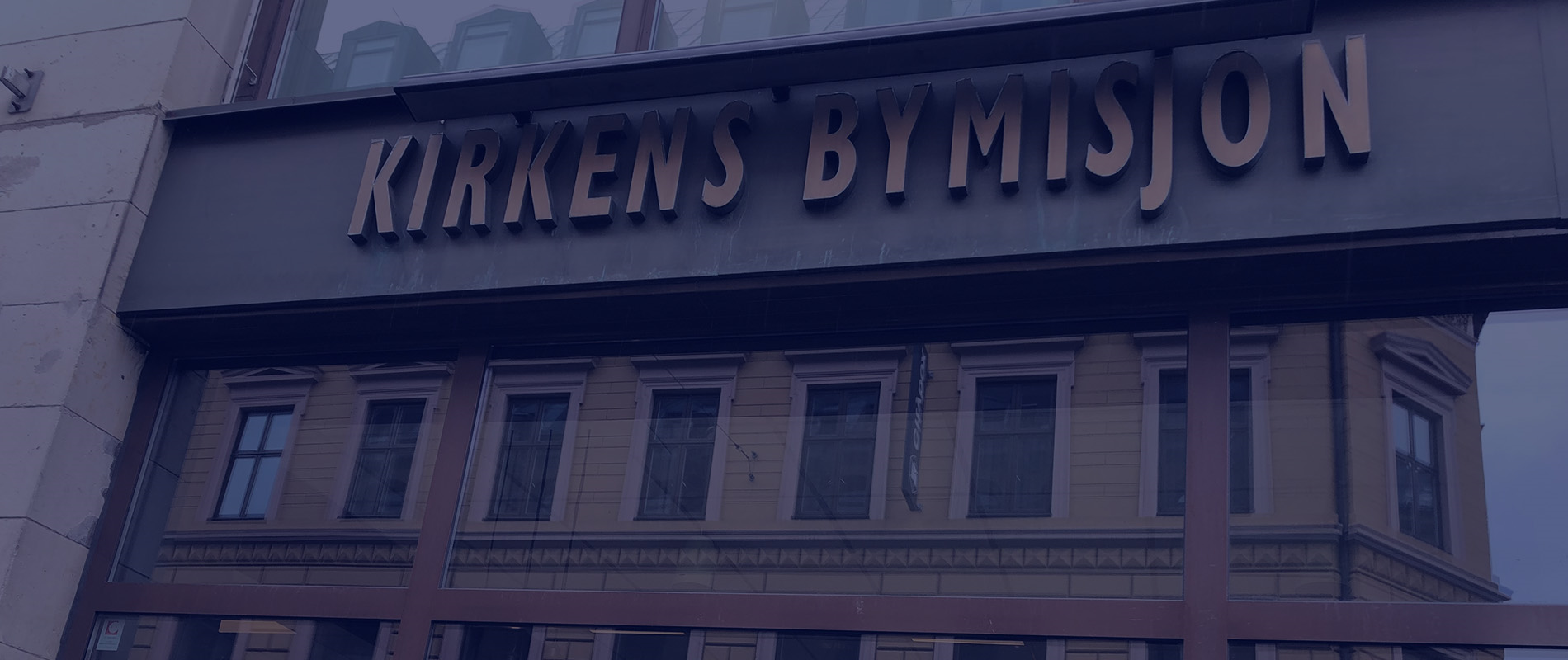Kirkens Bymisjon’s cloud journey: one step closer to heaven
The non-profit organisation has moved its infrastructure into the cloud, improved their security, and acquired a modern interaction platform
The non-profit organisation has moved its infrastructure into the cloud, improved their security, and acquired a modern interaction platform

When their IT operations agreement was about to run out, Kirkens Bymisjon needed to act. Inspired by Ullensaker municipality's cloud journey, CIO Janne Sørensen reached out to Innofactor. Now, the non-profit organisation has moved its infrastructure into the cloud, improved their security, and acquired a modern interaction platform. A significant reduction in IT operating costs is in the horizon.
We meet a bubbly and proactive CIO in Kirkens Bymisjon's offices in Oslo. The IT department has quickly transformed itself from "fire extinguishers" putting out fires on an infrastructure with significant technical debt, to "heroes" creating opportunities for interaction and cooperation for the organisation's employees throughout Norway.

"I always make jokes about the title of our cloud journey: 'Closer to Heaven: A Cloud Journey with Kirkens Bymisjon,'" Janne Sørensen laughs.
Kirkens Bymisjon is an inclusive non-profit organisation working across Norway, and more specifically with people who are facing challenges in life for various reasons. Their belief is that everyone deserves respect, justice and care, and they provide social care in Norway driven by human values. Their areas are substance abuse care, mental health care, child protection and family work, care for the elderly, prostitution and work measures, diversity work and church activities.
Kirkens Bymisjon consists of approximately 1,800 fulltime employees and 4,500 volunteers, with offices in 50 different cities.

Let us go back to autumn of 2021. A pandemic has swept across the country, and the IT department at Kirkens Bymisjon is losing several employees, they are in process of merging several regional foundations – and 1,5 years away from the expiration date of an existing IT operations agreement.
"I thought, what do we do now? We had a real opportunity to gradually move into the cloud, but I did not think a total move would be possible," Sørensen says.
She came across an article about Ullensaker municipality and what they had been able to achieve in only few months with Innofactor. She made contact and conversations were carried out with both Ullensaker and Innofactor, individually and together.

"After these conversations I thought it might just be feasible after all, and that it would make the journey we needed possible," Sørensen says.
Thus, a collaboration was born, with Innofactor on a preliminary project to analyse and estimate the size of the project, the concept, and the complexity for Kirkens Bymisjon. This phase lasted four weeks and was based on the Microsoft Cloud Adoption Framework (CAF).
"We went through the report and saw that it was possible, but what we had not realized was that Innofactor could only help us with parts of the journey. Everything related to computers, computer administration, print and network came outside of that – as well as the support we had through our operating supplier at the time," Sørensen says.
The decision was made. Their journey would begin following Easter 2022. Sørensen speaks of a clear mandate, with support from the rest of the management, although some insecurities were detected. However, the technical debt on the infrastructure, computers and network had created a considerable need for a digital lift. The management understood this. The fact that they would gain greater control over future costs, and gain predictability rather than "waiting for fires and then putting them out", reinforced the understanding and support.
"I prepared them for a trip across the Atlantic in a tiny sailboat, and the only certain thing was that we would encounter large waves on the crossing. No one knew if the mast would break or if we would need a lifeboat underway. For that reason, it felt even better saying that we were about to dock safely in autumn of 2022," Sørensen says.
The CIO says that the implementation of the plans exceeded all expectations. The biggest challenge was that Bymisjon had not had time to move the application portfolio to the cloud prior to project start, so it had to be done during instead. Only then could Innofactor transfer the remaining applications to Bymisjonen's cloud solution IAS in Azure.

Kirkens Bymisjon was based on standard applications, with some suppliers not offering cloud services at all. They went through the list of suppliers, and those without a cloud service for their applications were moved into the new Azure platform.
Some of the providers without a cloud service offered hosting partners where Kirkens Bymisjon could access the applications via the internet, as a temporary solution. This made all application operations running on their own infrastructure a thing of the past.
"We successfully finished this part of the project in September 2022. Innofactor's people are very talented and great to work with. They had a Scrum Master who handled the project, and a defined team with roles that we mirrored internally. When necessary, I communicated directly with the managing officer of Innofactor, as well as a dedicated Key Account Manager. This really is a sunny story," says Sørensen.
Alongside the cloud project, the IT department in Kirkens Bymisjon gained eight new employees, and an upgrade of internal cloud expertise, including its own cloud architect. With all the merged departments in place, the internal IT department counts approximately 20 people. The organisation has also entered into a service agreement with Innofactor.

Historically, Kirkens Bymisjon operated the Norwegian counties of Østfold, Møre, Trøndelag and Nordland, as well as Oslo. A merger of all the other organisations around the country was close to completion, and offered an extension of the collaboration with Innofactor.
According to Janne Sørensen, the merged organisations create a good mix of on-premises environments and environments that have already taken a few steps into the modern world.
"Our last three branches in Oslo will be completed over Easter 2023. The roll-out went like this: All of the employees have been given a new work surface and has been moved over to the cloud. So far, we have moved over a thousand computers."
Moving from on-premises to the cloud has also meant changing the way that they work. Although Kirkens Bymisjon does not build apps or services yet, one of the motivations for moving into the cloud was to achieve greater collaboration within the organisation. Innofactor has delivered a comprehensive file migration to Teams/Sharepoint/OneDrive with a range of security products, including identity management with two-factor authentication.
Sørensen says that the biggest change for the organisation was the relocation of the file servers.
"I did not see that one coming. We are used to cloud storage in the IT-department, but the rest of the organization had used "K:" – a local server they were confident using. Now they were moving into the cloud with opportunities for sharing and interaction via Teams and their own Sharepoint area. We have led some training, but it takes time for an organisation to understand new systems and adapt their ways of working accordingly."
Migration from on-premises to the cloud hasn't caused internal resistance at Kirkens Bymisjon. However, some challenges have arisen.
"We have had to tighten our security considerably. It complicates things, and not everyone immediately realises that it is for their own good."
At the same time, a dream has come true for everyone who are given new work tools as part of the major modernization.
"They simply look at the computer to identify themselves, and suddenly they are logged in. I have never been in an IT department where I have received so much praise. Our employees are incredibly happy with their new work platforms. The team has done a great job. There are always some who struggle a bit during a transition like this, but the simplicity of the structure this project has given the organization is a huge boost. Of course, the journey will take some time though."

Saving operational costs can serve as a motivation for migrating to the cloud. In the case of Ullensaker municipality, they recognized the opportunity to allocate potential savings towards service development, benefiting the municipality's residents instead of spending them on IT solution operations.
Regarding Kirkens Bymisjon, a non-profit organization with various worthwhile causes, the focus is on potential savings that could be reallocated for other purposes.
"My estimation of savings would be a 25 percent reduction in costs compared to previous expenses. However, due to various unknown factors, it is challenging to provide an exact number," Sørensen says.
She further explains that due to the merger of multiple Bymisjon departments, including those that were not present historically, along with the implementation of a service agreement and enhanced security measures, it becomes challenging to make a direct comparison between the overall services provided in the current solution and the previous one.

Kirkens Bymisjon has also implemented Innofactor Managed Detection and Response – a service that monitors and responds to cyber threats, as well as keeping them under wraps. The service includes a Nordic and multi-local Cyber Security Operations Center (CSOC) with a team of security analysts.
This team continuously works to detect security breaches that exist in the customer's endpoints, networks and cloud environments in real time and analyse, prevent, and report them to the customer for further actions.
"With the expertise Innofactor has in this specialist area, combined with the IT security resources we have internally, security is significantly amped up compared to where we were previously. There is a lot of straight-out-of-the-box functionality that we use. Combined with the cloud project, we have a full overview of who has access to what and when. I have a greater sense of security now," Sørensen says.

According to Sørensen, Kirkens Bymisjon is planning on making the most of their cloud environment.
"It will be a milestone in the fall of 2023 when all regions and users are in the cloud. Then we will have a large virtual pool with various projects focusing on improvements, automation, and efficiency-increasing projects that we are about to embark on. Next, we get to look at service development; what we can offer in terms of new services based on our completely new and modern platform that have given us opportunities we lacked before."
"Our first step is to complete the migration of all regions and users to the new platform. I usually say that the foundation must be stable before we can build the house we want," Sørensen concludes.

"Innofactor's people are very talented and great to work with. They had a Scrum Master who handled the project, and a defined team with roles that we mirrored internally."
Janne Sørensen
CIO
Kirkens Bymisjon
The following solutions and technologies, among others, are a part of of the overall solution delivered to Kirkens Bymisjon: